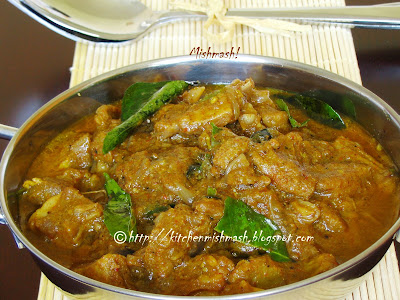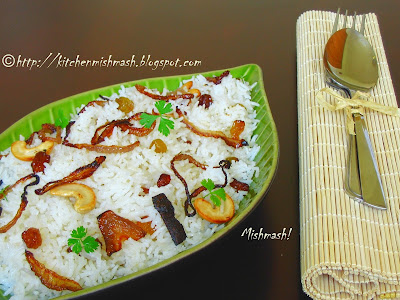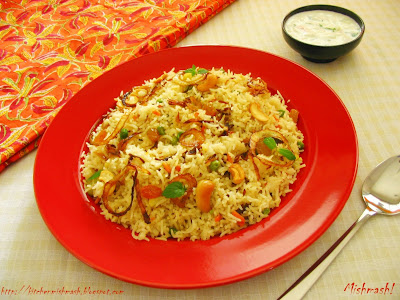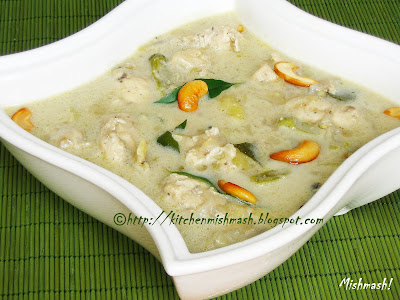
A name I heard occasionally from the women at my paternal side……...a picture or two I saw at the time I started scanning through the food blogs on Kerala cuisine……and when I browsed through those recipes, the doubts that evolved, based on a murky memory of me, tasting the same at a very tender age when my taste buds were not matured enough to tolerate such a taste, yet uncertain enough to buy that skeptical mind…..the state of being intimidated seeing the recipes and methods and the fear to try out something without any point of taste-reference in the past ……..and the (mis) perception that slowly got absorbed into my head that it is a northern Kerala delicacy ……..that was pretty much the data , the hard-disk of my brain could extract whenever I saw the word Kalathappam/kalthappam ! !

And then came that comment around three months back, from someone named Revathy, a name unfamiliar to my comment section till that day and she left this message :
“Hi mish,I was googling for kinnathppam recipe and one link was to ur site,and you wanted to know the kalathappam and kinnathappam recipe.I am from Kannur so kalthappam is one of our teatime snack back in india.I made it today after a long time and came out so well so I thought of sharing it with you as you want to know the recipe.Well about kinnathappam is normally made in large quantities and its a long process ,I remember once that was made in our home in big Uruli with 2-3 people continuosly stirring it for hours. my kalathappam came out good for the first in US.I tried soaking grinding basmati and other rices but didnt came out well. I used Nirapara Aripodi this time. here it is goes: nirapara aripodi 2-3cups, Vellam/Jaggery - as per sweetness, cooked rice - 1 cup, cardomon -6-7 , thenga kothu -11/2 cup, small onion - 1/2 cup, cumin seeds - 1/2 tsp, baking poweder - 1tsp, ghee /cocnut oil- as per req ……… Make a batter with rice powder ,melt the jaggery mix it well then grind the mix with cumin seeds ,cardomom , baking powder and cooked rice.the consistency of the battery kind of loose not so thick. then leave the mix for 2-3 hours room temp. Now heat the entire batter continously stirring ,be careful at this time,u shud keep stirring all part as it get cooked else.heat it for 2-3 mints. heat coconut oil or ghee in the pressure cooker roast thengakotthu and onions add some cardomom powder also.once it started turning brownish remove it from the cooker.then add some more ghee or cocnut oil again spread it little on the sides of the cooker since appam puffs out ,so it will stick on the sides.now pour the mix in the cooker then scatter the fried thngakotthu and onion.keep the stove on high then close the lid without Whistle .cook for 3 mints on high flame now fully lower the stove cook it in low flame for 10 mints turn off the stove. leave it for 30 mints and open the cooker.carefully remove it from the sides first then it will easily come out if u put the cooker upside down slightly on a plate. This is not a comment Shn. Love “
Revathy’s admiration for the snack from her hometown, her passion for cooking and open mindedness to share the recipe and moreover, the care and trust that she showed in me that I would be giving it a try for sure, was enough to earn my respect , both for the person and for the recipe she shared with me. As much as I was intimidated by the method and the pressure cooker steaming part, I gave it a try two months back ,by halving her recipe . Though we developed an instant liking at the first bite itself, the texture of my steamed version was not anywhere close to what she had painted or what I had seen earlier in other blogs. The bottom layer of fried coconut slices and onion got burnt and the texture was no where near the word, fluffy. I knew I messed up at the consistency of the batter as well as the temperature control department. After a couple of mail exchanges with Revathy, she gave me some important pointers like “practice of using raw rice for grinding, instead of rice flour….picking rice that is not starchy at all….and the liquid like consistency of the batter ….and mixing the ghee roasted coconut and onion slices to the batter instead of layering at the bottom to suit the electric stove temperature setting…“
In the meantime, I had asked my mother to get in touch with my aunt from kannur, knowing very well that I was on the right track. And on a crumbled piece of paper, I got to read my aunt’s recipe jotted down by my mother during her telecon and that piece of paper carrying my aunt’s instructions gave me the crucial info which said “ grind 1 glass kaima rice or biryani rice with 1 1/2 tbsp cooked rice and sharakkara-paavu/jaggery syrup thoroughly without adding water or very little water ( if required) to a dosa batter consistency and later heat it in cheru-theeyil/low heat…” and the picture and recipe given below is from the recent second attempt , under the guidance of my mother.

Here the main frame-work is based on Revathy’s recipe and supported by my aunt’s instructions and tips on the process. My aunt’s recipe doesn’t mention baking powder and it is very obvious that it is not a conventional choice either. But from the very little information I was able to collect on this topic, conventionally Kalathappam/kalthappam, was not cooked in pressure cooker either. What I learnt was , it is cooked in a Uruli/bell metal vessel and cooked covered with a lid, topped with some coal/dum method- a conventional style of baking. Please correct me, If I am wrong! But just like some out there who started using baking powder as a short cut to give fluffiness in deep fried fritters like Uzhunnu Vada, Pazhampori et al or replacing the dum method with oven baking for making biryani, here in this recipe also, I feel the use of baking powder and pressure cooker steaming is a modern day interpretation to get the old world taste staying within the given functionalities of our modern day kitchen.
(Recipe Source: Revathy from Kannur ; Instructions : My aunt from Kannur )
Ingredients:
- 1 cup Kaima /jeerakasaala rice soaked for about 4-6 hours
- 1 cup melted & filtered light brown jaggery/Vellam/Sarkkara thick syrup ( Adjust as per sweetness and consistency of the syrup)*
- ¼ cup cooked rice, loosely packed
- ¼ cup thengakothu/ small coconut slices
- ¼ cup Kunjulli/red small pearl onion, thinly sliced
- 4 pods of Elakkaya/cardamom
- ¼ tsp Jeerakam/cumin seeds
- 1/2 tsp to 3/4 tsp baking powder
- Salt to taste
- 3tbsp ghee/clarified butter
Directions:
- Wash and soak rice for about 4-6 hours; drain the water and grind in a mixer along with melted jaggery, cooked rice and a pinch of salt, to a fine/smooth and pouring consistency batter ( like dosa/vattayappam batter) without adding water. Towards the end, add cardamom, cumin seeds and baking powder and grind and mix well with the batter. Pour this to a saucepot and leave it on the kitchen counter for about 1 hour.
- Heat ghee in a small pressure cooker and fry thengakothu/ small coconut slices till golden brown, in medium heat. Remove with a slotted spoon to another plate; now add the sliced small onions and sauté till lightly browned/caramelized and remove with a slotted spoon and keep it aside.
- Now heat the batter in the saucepot, in very low heat and stir continuously, until the batter is warm to touch. (Note: Please do not let the batter cook at this stage; it’s only meant to be warmed a bit.) At this stage remove from the heat and continue stirring , else the temperature of the saucepot would continue to cook the batter at the bottom, creating lumps which is to be avoided by stirring continuously.
- There is enough ghee left in the pressure cooker now and swirl the cooker to give a coating of ghee on its sides. Quickly mix half of the fried coconut and onion slices to the batter and pour to the pressure cooker and top with the leftover fried coconut and onion slices; lock and secure with its tight lid, with rubber and without the weight/whistle………: I do not have a gas stove and controlling the cooking temperature is very tricky and significant in this case. Hence, Electric stove users with coiled burners, need to be a bit cautious. On my mother’s suggestion, we heated two small burners at the same time and kept one in low heat (at 3 )and the other at medium ( at 5) and cooked the first 2 minutes in medium heat and then moved the cooker immediately to the one with low heat and cooked for around 18-20 minutes; after turning off the heat, moved the cooker to another unused burner and left it there for the next 15 minutes. (Note: I think, Gas stove users can cook in high heat for about 2 minutes and reduce the heat to low and continue cooking for the rest of the cooking time as heat controlling is easier with gas flames ). Now , Open the cooker carefully and check its doneness by inserting a knife or wooden skewer and if it comes out with very little crumbs here and there or none at all, with its edges separated from the cooker, then it is cooked to perfection. Now let it cool completely. At this point, keep a plate, slightly bigger than the cooker and invert carefully and gently and the steamed cake would come off easily. If you’ re having trouble, gently try to lift the steamed cake with a flat spatula, from the bottom and sides and then try to invert ; once you get Kalathappam/Kalthappam perfectly round in shape, gently flip and serve with the crowned part as the top ; slice into wedges and serve with tea/coffee.
Based on the very little information I could grab on this snack, I had a strong inclination to brand this snack as a Northern Kerala delicacy as it is generally perceived to be, until I saw this video below from a cooking segment, telecast by a Malayalam TV Channel. For those who cannot understand Malayalam, this segment throws light into the fact that Kalathappam is a popular snack, not just in Northern Kerala but around the extreme Southern regions of Kerala too, though with a slightly different interpretation which can be beautifully categorized under the term, regional variation. In these parts, they call this snack Kalathappam or Melchatti Appam. The main variation in this recipe is the use of cooked green grams/cheru-payar and the video shows how ingredients like rice flour, jaggery, coconut and cooked green grams are blended and stirred continuously to a thick batter and finally finishing the cooking with ghee roasted nuts and raisins, drizzled with more ghee and then covered and topped with coal to finish off the final cooking. That makes me conclude that at times, there is a general tendency on some of our part to generalize a cuisine without having proper research or based on some half cooked information out there or simply because of our ignorance or lack of understanding.
Check out Mallugirl’s Kalathappam & Seena’s Version too.
A bouquet of thanks to Revathy , My aunt and my mother :)
Luv
Shn















